For this week’s recitation, I built a circuit with my partner and made a DIY cardboard switch. Then we replaced the push button with the newly soldered DIY paddle and sent a message in morse code with it.
Task 1
The first circuit made a beep sound, which was made by the buzzer. The second circuit was a parallel circuit and had a led light and the beep sound. The third circuit could make beep sound, had two led lights and the brightness of one of them could be adjusted.
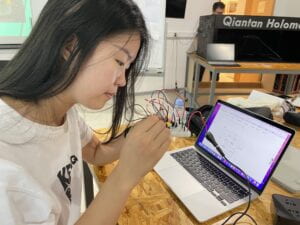
My group had some problems during the circuit and turned to the assistants from upper classes for help. After rechecking everything, we found that we didn’t fully understand how to use the breadboard and made some mistakes. After solving the problem , we were able to make the beep sound and were very happy about this. Then, problems arouse again when we were building the second circuit, we checked the connection of the circuit again and again but failed to find the wrong connection. Finally, the circuit worked, but we didn’t know exactly which part made it work, and that’s something we need to learn about and work on next time.
It was a great experience to work with someone and finish the circuit together, especially when I had an awesome partner. We had no problem communicating with each other and we always agreed with each others idea. Also, we split the work so that both of us can practice building the circuit and have a fun lab experience.
Task 2
In task 2, each of us were brought to soldering stations to build a paddle using cardboard, copper tape, and wires. Then we combine the paddles into a switch. When we were building the switch, we used soldering irons, which melts the solder to connect the wire and the metal tape. I finished all these process very quickly because I learned how to use the soldering iron in primary school, and it felt good using it again to build something that I have never made before.
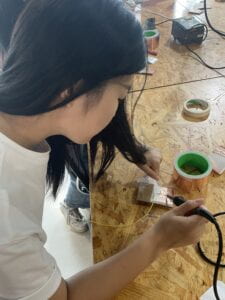
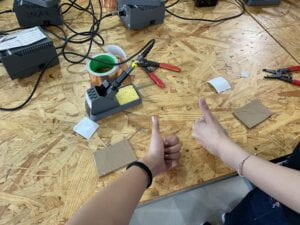
Task 3
In task 3, we replaced the push button with the newly soldered DIY paddle, and were supposed to send a message using the morse code. But actually we didn’t have time to send a message. I think it’s because we weren’t familiar with the components and it took us more time than the time we should spend on building the circuit. But now that we know the importance of managing time, next time when we are building a new circuit and doing a new task, I believe we can do it better and finish it all.
When the class was already over and me and my parter haven’t finish building the circuit, both of us were worried about it. But none of us complain about each other, instead, both of us tried comforting and encouraging each other. And that means we had a really good team and very good teamwork, this kind of support is exactly what we want from a group and from the partner.
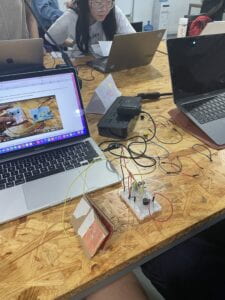
Additional Required Questions:
Question 1:
The resistor R1 helps limit the current that passes through the LED1 and make sure it doesn’t exceed the current rating allowed for the LED.
Question 2:
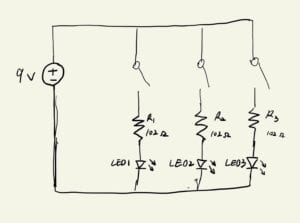
Question 3:
The circuit I built today could send secret messages using morse code to others, that’s a way of communication, which is an crucial part of interactivity. I would say it’s a “low” interactivity because the quality the communication we had through the morse code wasn’t good at all, and that doesn’t contribute to a intense and rewarding conversation.
Question 4:
Zack Lieberman says that he would connect creative coding to poem, and demos to poems. He also says poems are really beautiful expressions of what it means to be human and to be alive. And me personally do think that’s what we want from Interactive Art, which is a bran new expression of us human and our lives.
We use Interaction Design and Physical Computing to express the way humans communicate with each other and communicate with other things on this planet. Sometimes we attempt to design within the limits of human body and expression to create more impressive Interactive Art.
Leave a Reply